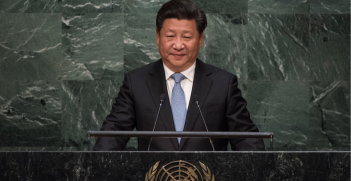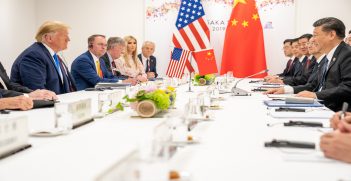Book Review: China Incorporated

How should the West view China’s rise on the global stage? Kerry Brown’s China Incorporated challenges common misconceptions of China’s rise and ambitions.
Kerry Brown’s China Incorporated makes a provocative argument: China is not a malevolent actor hellbent on global domination at any cost. “Provocative” and timely, because it challenges the incomplete but dominant characterisation of China as a monolithic actor and global threat. Of course, this is not to suggest that Chinese foreign policy practices cannot be threatening – Brown himself acknowledges the concerns that China is causing with its rise, and the suspicions that it engenders – ranging from its activities in the South China Sea to its practices in Hong Kong and Taiwan. Nevertheless, Brown correctly argues that simplistic assessments fail to capture the complexity and nuance of China’s rise and urges readers to move beyond these oversimplified portrayals. He also rightly surmises that the foremost priorities of the Chinese Communist Party (CCP) remain domestic, namely internal coherency and unity. Brown also writes convincingly on the three sets of realities everyone needs to face up to. That is, China is no longer a weak marginal power, as it had been for a prolonged period, but a strong, consequential global actor. China is now not just a continental power but is a sea power able to project and police maritime areas near and far. Furthermore, China has a distinct and “structurally different” set of values and culture from the West but without any universal illusions of its unique Chinese values.
There is much to like about the book. Quite sweeping in the themes it covers – from Chinese culture and history to the Belt and Road Initiative (BRI), and even the philosophy of François Jullien – it imagines a world where China shares power with the West and accounts for the multiple obstacles that prevents this.
Brown deconstructs common misconceptions of objects and initiatives that have somewhat uncritically been taken as unmitigated threats, especially as seen from the West. For instance, he convincingly weaves together an account of the much-maligned Confucius Institutes and how this project was hamstrung by disjointed, patchy coordination with the Chinese state, and were much more flexible, opportunistic, and dynamic than what people typically portray them to be. This is similar to Brown’s account of the BRI and its economic power. He illustrates how the BRI is driven by sub-state actors whose intentions are more profit-driven and not necessarily as strategically driven as what many in the West assume. Indeed, observers sometimes give very little credit to recipient countries who can strategically play off China’s largesse, and are not simply passive receivers of Chinese goodwill, cheap loans, and aid. Relatedly and importantly, Brown rejects the notion of China as a single, unified entity controlling every aspect of its foreign engagement. In fact, we still see China failing to positively promote itself and having troubles “telling China’s story well.”
Brown further acknowledges and stresses China’s distinct value system while rejecting the claim that it seeks to impose these on others. He argues – not unproblematically – against depicting China as solely focused on exporting its values, stating that while China may not subscribe to Western notions of liberalism and individual rights, China is not in the business of exporting its own values and norms. A more nuanced understanding of China’s role in the world today, he hopes, will encourage a more balanced understanding of potential areas of cooperation and friction between China and the West, while acknowledging that differences in values alone do not automatically translate into antagonism.
At times, however, Brown’s arguments veer almost completely towards cultural explanations, potentially overplaying the role of history and culture in understanding China’s behaviour. This reduces the agency of individuals and institutions within the country and creates a sense of cultural essentialism. While acknowledging the influence of historical and cultural factors is necessary, Brown occasionally slips into culturalist argumentations. He notes, for example, there is “precious little sign that it is, at least rhetorically, in the business of imposing its values on others.” Some may perceive such charges as aligning with the Chinese narrative about its “unique” nature and its claims about how peace and peace-making are in the Chinese culture or “DNA.” Elsewhere, he contends with the malleability of Chinese culture and ideology, writing: “The fact is that most Chinese have a light and flexible relationship with ideologies, and that includes socialism with Chinese characteristics.”
While challenging dominant narratives, Brown leaves some questions unanswered. For instance, he acknowledges China’s desire for “recognition” but doesn’t fully explore what this entails and how it translates into concrete foreign policy goals. Moreover, discussion about internet and virtual power – a clearly important prong of China’s power today – was a missed opportunity to dive deeper into the concept of “cyber sovereignty” that is so central to Xi Jinping’s ideas of the internet. Additionally, Brown perhaps goes too much into the specificities of Europe, and by extension, the EU’s own internal problems that sometimes distract from his main points. Even so, the author does accurately capture a key grievance of Beijing: no country, grouping or institution can moralise or lecture China on how to govern and run its own affairs, expecially those with their own chequered history. The author, in his zeal to spotlight the West’s hypocrisy and pontification, comes across as too assertive by repeatedly highlighting the problems of the West and how wrong-headed they were in their predictions of China. The book also leans heavily on the US-China story, and “West versus China” dynamics. While he does mention the African continent, he leaves readers wondering where Southeast Asia, the Middle East, and South Asia figure in this narrative.
Ultimately, China wants to rise and have its influence and power legitimately recognised. Paraphrasing Brown, Beijing wants power without the commensurate responsibility, and “despite the conviction of so many in the outside world about its disruptive behaviour, one of China’s greatest desires was for partners that did not rock the boat and cause turbulence.” All in all, China Incorporated offers a valuable contribution by offering a nuanced and critical perspective on China’s rise. It encourages readers to move beyond simplistic narratives and engage in a more sophisticated understanding of this complex nation. Most importantly, while the West does have genuine concerns about Chinese activities, at home and abroad, and actively seeks to manage these, it would neither be possible nor accurate to formulate China and its rise in binary terms. As such, the onus and responsibility to ensure peace is not China’s alone to bear. Herein, one of his final comments on this is instructive: “China upsets the epistemology of the West – it violates notions of universalism being universal.”
Dylan M. H. Loh is an Assistant Professor with the Public Policy and Global Affairs Division at Nanyang Technological University, Singapore.
This review is published under a Creative Commons License and may be republished with attribution.





